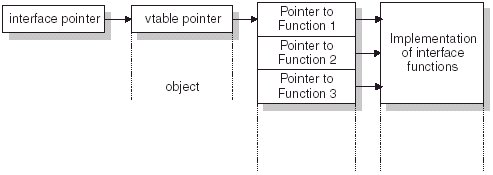An interface pointer is a pointer to an object instance that points, in turn, to the implementation of each method in the interface. The implementation is accessed through an array of pointers to these methods, which is called a vtable. Vtables are similar to the mechanism used to support virtual functions in Delphi. Because of this similarity, the compiler can resolve calls to methods on the interface the same way it resolves calls to methods on Delphi classes.
The vtable is shared among all instances of an object class, so for each object instance, the object code allocates a second structure that contains its private data. The client's interface pointer, then, is a pointer to the pointer to the vtable, as shown in the following diagram.

In Windows 2000 and subsequent versions of Windows, when an object is running under COM+, an added level of indirection is provided between the interface pointer and the vtable pointer. The interface pointer available to the client points at an interceptor, which in turn points at the vtable. This allows COM+ to provide such services as just-in-time activation, whereby the server can be deactivated and reactivated dynamically in a way that is opaque to the client. To achieve this, COM+ guarantees that the interceptor behaves as if it were an ordinary vtable pointer.
|
Copyright(C) 2009 Embarcadero Technologies, Inc. All Rights Reserved.
|
|
What do you think about this topic? Send feedback!
|